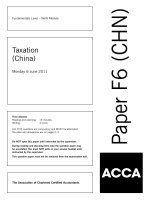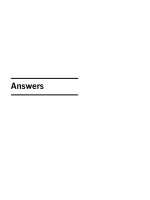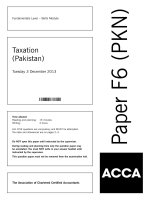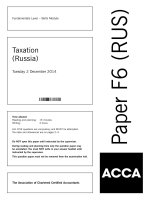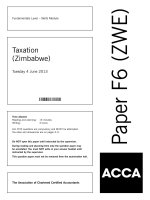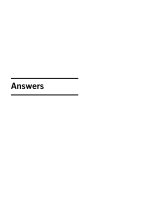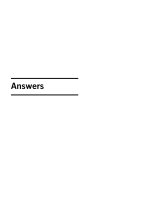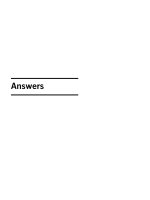ACCA f6 taxation zimbabwe 2014 dec question
Bạn đang xem bản rút gọn của tài liệu. Xem và tải ngay bản đầy đủ của tài liệu tại đây (313.68 KB, 14 trang )
Taxation
(Zimbabwe)
Tuesday 2 December 2014
Time allowed
Reading and planning:
Writing:
15 minutes
3 hours
ALL FIVE questions are compulsory and MUST be attempted.
Tax rates and allowances are on pages 3–5.
Do NOT open this paper until instructed by the supervisor.
During reading and planning time only the question paper may
be annotated. You must NOT write in your answer booklet until
instructed by the supervisor.
This question paper must not be removed from the examination hall.
The Association of Chartered Certified Accountants
Paper F6 (ZWE)
Fundamentals Level – Skills Module
This is a blank page.
The question paper begins on page 3.
2
SUPPLEMENTARY INSTRUCTIONS
1.
2.
3.
Calculations and workings need only be made to the nearest US$1, unless directed otherwise.
All apportionments should be made to the nearest month.
All workings should be shown.
TAX RATES AND ALLOWANCES
The following tax rates and allowances are to be used when answering the questions.
Tax rates – Individuals employment income
Year ended 31 December 2013
Taxable
income band
US$
Up to 3 000
3 001 to 12 000
12 001 to 24 000
24 001 to 60 000
60 001 to 90 000
90 001 to 120 000
120 001 and over
Rate
of tax
%
0
20
25
30
35
40
45
Amount
within band
US$
3 000
9 000
12 000
36 000
30 000
30 000
Cumulative income
tax liability
US$
0
1 800
4 800
15 600
26 100
38 100
NB. The AIDS levy of 3% is chargeable on income tax payable, after deducting credits.
Allowable deductions year ended 31 December 2013
Pension fund contribution ceilings
(a)
(b)
(c)
(d)
US$
5 400
5 400
2 700
In relation to employers: in respect of each member
In relation to employees: by each member of a pension fund
In relation to each contributor to a retirement annuity fund or funds
National Social Security contributions (on a maximum monthly gross
salary of US$700)
Aggregate maximum contributions to all the above per employee per year
3·5% of gross salary
US$5 400
Credits year ended 31 December 2013
US$
900*
900*
50%
50%
Disabled/blind person
Elderly person (55 years and over)
Medical aid society contributions
Medical expenses
* The amount is reduced proportionately if the period of assessment is less than a full tax year.
Deemed benefits year ended 31 December 2013
Motor vehicles
Engine capacity:
Up to 1500cc
1501 to 2000cc
2001 to 3000cc
3001 and above
US$
1 800
2 400
3 600
4 800
3
[P.T.O.
Loans
The deemed benefit per annum is calculated at a rate of LIBOR +5% of the loan amount
advanced.
Value added tax (VAT)
Standard rate
15%
Capital allowances
%
25
25
Special initial allowance (SIA)
Accelerated wear and tear
Wear and tear:
Industrial buildings
Farm buildings
Commercial buildings
5
5
2·5
Motor vehicles
Movable assets in general
20
10
Tax rates – Other than employment income
Year ended 31 December 2013
%
Companies
Income tax: Basic rate
AIDS levy
25
3
Individuals
Income tax: Income from trade or investment
AIDS levy
25
3
4
Capital gains tax
On marketable securities
20% of gain
Disposal of listed marketable securities acquired after 1 February 2009 1% of gross proceeds
Disposal of specified assets acquired prior to 1 February 2009
5% of gross proceeds
0%
On principal private residence where the seller is over 55 years
On other immovable property acquired on or after 1 February 2009
20% of gain
Inflation allowance
2·5%
Capital gains withholding tax on sale proceeds
Immovable property
Marketable securities (listed) acquired before 1 February 2009
Marketable securities (unlisted)
Note: The withholding tax is not final on the seller. Actual liability is assessed
in terms of the Capital Gains Tax Act.
%
15
5
5
Withholding taxes
On dividends distributed by a Zimbabwean resident company to resident shareholders
other than companies and to non-resident shareholders:
By a company listed on the Zimbabwe Stock Exchange
By any other company
Informal traders
Foreign dividends
%
10
15
10
20
Non-residents’ tax
On interest
On certain fees and remittances
On royalties
%
nil
15
15
Residents’ tax on interest
From building societies
From other financial institutions (including discounted securities)
%
15
15
Elderly taxpayers (55 years and over)
Exemptions from income tax year ended 31 December 2013
Rental income
Interest on deposits with a financial institution
Interest on discounted instruments
Income from the sale or disposal of marketable securities
Pension
US$
3 000
3 000
3 000
1 800
No limit
Income from the sale or disposal of a principal private residence is also exempt.
5
[P.T.O.
ALL FIVE questions are compulsory and MUST be attempted
1
Anne Gray, aged 56, is a foreign languages teacher at Mountaintop School, a private boarding school in Rusape. Anne
has been in the teaching profession for the last 30 years. On 1 March 2013, the school promoted Anne to the head
of the languages department, which is an administrative position. She can also be subcontracted to other schools and
foreign languages associations to assist both their teachers and students during her free time. Anne also holds a
contract with the Ministry of Foreign Affairs as an interpreter on a consultancy services basis.
On 5 January 2013, Anne entered into a consultancy agreement with the Ministry of Education to translate some
local textbooks. The project is for three years ending on 31 December 2015. Payment is only effected on completion
of the translation of the textbooks and the agreed amount is US$5 000 per translated textbook.
Details of Anne’s income for the year ended 31 December 2013 are as follows:
Employment income and benefits
(i)
Anne receives a gross monthly salary of US$4 000 and an annual bonus equal to one month’s gross salary
payable in the month of December.
(ii)
Anne’s two daughters are students at Mountaintop School and the school pays 100% of the tuition fees, levies
and boarding fees on Anne’s behalf. One of Anne’s daughters attends a special class for the blind at the school.
The total tuition fees, levies and boarding fees for both Anne’s daughters amounts to $27 000.
(iii) Anne makes use of a fully furnished house at the school staff residential area. The school deducts a monthly
rent of US$300 from Anne’s salary. The fair value of the benefit she derives from the use of the house and
furniture is US$250 for the house and US$150 for the furniture on a monthly basis.
(iv) Upon Anne’s appointment as the head of the languages department, the school offered her a new motor vehicle
with an engine capacity of 3300cc for her private use. Previously she made use of a school vehicle with an
engine capacity 2000cc. The school allowed her to buy the old vehicle for US$2 000. The old vehicle was
purchased five years ago for US$10 000. The current market value for a similar vehicle is U$5 000.
(v)
Anne contributes 7·5% of her salary monthly into a registered pension fund. The school deducts her statutory
NSSA contributions which amounted to US$202 for the year. Between 1 January 2013 and 31 May 2013,
Anne contributed a total of US$1 500 towards a retirement annuity fund which matured on 3 June 2013. She
immediately became entitled to a monthly annuity of US$750 for the next ten years.
(vi) Anne is a registered member of a medical aid society and during the year, a total of US$8 000 was paid as
medical aid contributions for herself and her family. The Mountaintop School paid 60% of these contributions
while the remainder were deducted from Anne’s salary.
(vii) Anne received a total of US$12 000 in acting allowances from the Mountaintop School during the year.
(viii) The school deducts the following amounts monthly from Anne’s salary upon her instruction and pays the relevant
amounts to the institutions concerned:
Subscriptions to the Zimbabwe Teachers Union
Funeral policy to Perfect Peace Funeral Services
Life insurance policy to Royal Life Insurance Services
US$
15
100
50
(ix) The school paid a total of US$17 000 to the Zimbabwe Revenue Authorities (ZIMRA) for Anne’s PAYE for the
year ended 31 December 2013.
Other non-employment income
(x)
Anne successfully translated four textbooks under the terms of her contract with the Ministry of Education.
(xi) Anne’s bank account was credited with a total of US$15 000 representing rental income collected by an estate
agent in respect of an investment property owned by Anne in Harare.
(xii) Anne raised invoices totalling US$30 000 for her subcontract work with other schools and foreign languages
associations. Anne paid Mountaintop School 10% of this amount under the terms of a standing arrangement for
use of the school’s resources.
6
(xiii) The Ministry of Foreign Affairs paid Anne US$10 000 for her services as an interpreter during the year.
Required:
(a) Explain, in general terms, how most fringe benefits are valued for tax purposes and how the valuation of the
benefits stated in (iii) and (iv) above differs from the general rule.
(3 marks)
(b) List the amounts to be exempted from Anne Gray’s gross income for the year ended 31 December 2013.
(5 marks)
Give brief reasons for your answers.
(c) Calculate Anne Gray’s taxable income and income tax payable for the year ended 31 December 2013.
Note: Indicate any amounts which are not taxable or not deductible by the use of zero (0).
(17 marks)
(25 marks)
7
[P.T.O.
2
Exquisite Baths Industries (Private) Limited (EBI) specialises in the manufacture of personal hygiene soaps and related
products at their factory in the southern industrial site of Harare. EBI commenced business operations on 20 April
2012 and had an assessed loss of US$112 000 for the period ended 31 December 2012 attributable to large
start-up costs in the first period of trading.
Turnover for the year ended 31 December 2013 amounted to US$1 980 000 of which US$700 000 related to export
sales. EBI is trying to increase its turnover from export sales through participation in foreign market trade fairs as well
as other marketing campaigns. The gross profit margin for the year ended 31 December 2013 was 60%.
EBI recorded a net profit of US$315 000 for the year ended 31 December 2013 after taking into account the
following transactions:
(i)
Net rental income of US$280 000 received from the leasing of one wing of the head office building situated in
the central business district (CBD) of Harare.
(ii)
A refund of US$20 000 representing value added tax (VAT) overpaid for the year.
(iii) Net interest received from local commercial banks of US$10 000.
(iv) The registration of three trademarks, ‘Cleanex’, ‘Perfect’ and ‘Alfresh’, at a total cost of US$30 000 in respect of
EBI’s personal hygiene soaps. The market research expenses incurred in connection with the development of
these soaps amounted to US$65 000. ‘Alfresh’ is a hygienic wet paper soap developed specifically to assist in
the efforts to fight cholera and other waterborne diseases in areas where there are erratic water supplies.
(v)
A donation of US$120 000 to a local council school as part of EBI’s corporate social responsibility programme.
(vi) Depreciation of fixed assets of US$67 000.
(vii) Marketing costs of US$88 000. US$25 000 of these costs were incurred when the export market development
manager attended two trade conventions and one trade mission as part of EBI’s efforts to increase its export
sales. The trade mission was duly approved. The remaining US$63 000 of costs were incurred in marketing
EBI’s soaps to foreign markets.
(viii) General repairs and maintenance costs amounting to US$140 000. US$28 000 of this amount was incurred
in underpinning the office building to strengthen its foundations against subsidence.
(ix) Exceptional costs amounting to US$290 000 as a result of the production manager incurring an injury whilst
working on one of the production lines in the factory. The production manager was rendered incapacitated as a
result of the incident. EBI settled out of court and US$250 000 of the costs relate to a payment made to the
production manager in full settlement of the case. US$50 000 of the US$250 000 out-of-court settlement was
paid in order to prevent the production manager from setting up a similar business in competition with EBI. The
remaining US$40 000 of costs represent fines imposed by the factory inspectorate following the incident. The
production line was also condemned as a result.
(x)
Rental expenses paid for the canteen building and equipment amounting to US$48 000. The canteen is owned
by another company. Other canteen expenses amounted to US$75 000 for the year.
(xi) Interest paid of US$30 000. The interest was incurred in respect of EBI’s US$200 000 overdraft facility.
US$100 000 of the facility was applied towards recurrent expenditure while the other US$100 000 of the
facility was applied towards the cost of a new showroom (see additional information note 2, below).
(xii) Other expenses incurred during the year amounted to US$230 000. ZIMRA considers 40% of these expenses
to be prohibited for tax purposes.
Additional information
(1)
EBI’s projected taxable income for the year ended 31 December 2013 amounted to US$360 000. The
accountant remitted the provisional tax for the three quarterly payment dates (QPDs) on time but, due to the
pressures of year-end work, forgot to submit the return for the final QPD. The accountant also omitted the
brought forward assessed loss from his computations of the provisional tax.
(2)
During the year a showroom was constructed in close proximity to EBI’s factory building. The showroom is used
to display the soaps from the factory as well as for storage purposes pending shipment to various destinations.
The showroom was constructed at a total cost of US$100 000 and was wholly funded by EBI’s overdraft facility.
The showroom was brought into use on 1 August 2013. EBI has made all tax appropriate elections in
connection with the showroom.
8
(3)
Details of EBI’s other fixed assets are provided below. These were all acquired/constructed during the year ended
31 December 2012:
Cost (US$)
200 000
110 000
120 000
60 000
50 000
80 000
Factory building
Plant and machinery (operates two shifts)
Office building
Furniture and equipment
Commercial vehicles
Three passenger vehicles
Required:
(a) Calculate the capital allowances claimable by Exquisite Baths Industries (Private) Limited for the year ended
31 December 2013, assuming all favourable elections are made. Your answer should explain the treatment
of the showroom.
(9 marks)
(b) Calculate the provisional tax which should have been paid by Exquisite Baths Industries (Private) Limited for
the year ended 31 December 2013, clearly indicating the due dates and the respective tax amounts.
(4 marks)
(c) Calculate the taxable income and corporate tax payable by Exquisite Baths Industries (Private) Limited for
the year ended 31 December 2013.
Note 1: Your answer should start with the net profit figure of $315 000 and list all of the items referred to in
notes (i) to (xii), indicating by the use of zero (0) any items which do not require adjustment.
Note 2: Your calculations should assume that the provisional tax paid was as calculated in part (b) of the
question.
(15 marks)
(d) Explain the tax advantage which may accrue to Exquisite Baths Industries (Private) Limited if, in future
years, it increases its export market sales as a proportion of total sales.
(2 marks)
(30 marks)
9
[P.T.O.
3
Jon Ndoro runs a business in Kariba near to where he currently lives. Jon relocated to Kariba in pursuit of his business
on 30 May 2011. Prior to this date, Jon lived in Harare where he owns a property, which is his principal private
residence (PPR). On his relocation to Kariba, Jon found a tenant for his fully furnished PPR in Harare and started to
rent out the property from 1 June 2011.
In order to fully fund his lucrative business venture, Jon entered into an agreement to sell his PPR to his tenant on
5 August 2013. One of the conditions in the agreement of sale was that the buyer would also acquire the movable
property together with the house. The sale price agreed was the market value of the property. A reputable estate agent
had valued the property as at 31 July 2013 as shown below:
Main residence
Concrete wall
Double lock up garage
Swimming pool
Swimming pool equipment
Furniture, fittings and equipment
Date acquired/
constructed
31 March 2009
15 January 2010
20 June 2010
28 February 2011
28 February 2011
25 May 2011
Cost
Market value
US$
US$
120 000
200 000
30 000
50 000
50 000
70 000
20 000
30 000
10 000
20 000
40 000
60 000
––––––––
––––––––
270 000
430 000
––––––––
––––––––
––––––––
––––––––
Jon incurred expenses amounting to 10% of the selling price in connection with the disposal of his property.
Additional information
(1)
On 22 December 2013, Jon offered his son a wedding gift of 10 000 listed shares. Jon had originally acquired
the shares in 2011 for US$0·50 per share. The market price of the shares as at 22 December 2013 was
US$2·50 per share.
(2)
Jon is fully tax compliant and has always opted to claim the maximum permitted capital allowances.
Required:
(a) Explain the capital gains tax implication of the wedding gift and calculate Jon Ndoro’s capital gains tax
liability associated with this gift.
(4 marks)
(b) Outline the tax treatment of a principal private residence which is used for business purposes.
(2 marks)
(c) Calculate the income tax and capital gains tax payable by Jon Ndoro as a result of the disposal of his principal
private residence in the year ended 31 December 2013.
(9 marks)
(15 marks)
10
This is a blank page.
Question 4 begins on page 12.
11
[P.T.O.
4
Kuda and Tonde Kupara are brothers and equal partners in their partnership business, K&T architects and structural
engineers.
The partnership is in its third year of trading and operates from office premises owned by Kuda. Tonde provides all of
the office furniture and equipment used by the partnership. In line with the partnership agreement, Kuda and Tonde
are entitled to a monthly payment equal to 5% of the cost of their fixed assets which are used by the partnership.
Kuda and Tonde use their own personally acquired motor vehicles for partnership business and charge the partnership
for the business mileage incurred.
The partnership employs three staff in addition to the partners. The partnership’s statement of profit or loss for the
year ended 31 December 2013 is as detailed below:
Income
Less expenses:
Distribution expenses
Administrative expenses
Other expenses
Profit for the year
Note
US$
730 000
1
2
3
(160 000)
(290 000)
(30 000)
––––––––
250 000
––––––––
––––––––
Notes:
1
Distribution expenses comprise:
US$
70 000
40 000
6 000
24 000
20 000
––––––––
160 000
––––––––
––––––––
Motor vehicle running expenses
Insurance and licensing
Parking fines
Business mileage claim: Kuda
Tonde
2
Administrative expenses comprise:
US$
40 000
60 000
60 000
18 000
10 000
10 000
8 000
20 000
8 000
5 000
3 000
6 000
4 000
23 000
15 000
––––––––
290 000
––––––––
––––––––
Salaries: Staff
Kuda
Tonde
Pension fund contributions: Staff
Kuda
Tonde
Insurance premium: Partnership joint life policy
Loss of profit
Partners life policies – Kuda
Tonde
Medical aid contributions: Staff
Kuda
Tonde
Depreciation
Repairs and maintenance
12
3
Other expenses comprise:
US$
16 000
14 000
–––––––
30 000
–––––––
–––––––
Interest on capital accounts: Kuda
Tonde
The following is an extract from the fixed asset register for the year ended 31 December 2013:
Cost Income tax value
US$
US$
130 000
120 250
80 000
20 000
60 000
5 000
Office premises
Office furniture and equipment
Passenger motor vehicles (2)
Required:
(a) Briefly explain, in general terms, how partnership income is taxed.
(2 marks)
(b) Calculate the joint partnership taxable income/(loss) for the year ended 31 December 2013.
(6 marks)
(c) Calculate the taxable income and income tax payable by both Kuda and Tonde for the year ended
31 December 2013.
(7 marks)
(15 marks)
13
[P.T.O.
5
AGL Communication Technologies Limited (AGL) is a category C registered operator for value added tax (VAT)
purposes and is in the business of selling and repairing computers and mobile phone handsets.
Details of AGL’s trading activities and transactions for the month of October 2013 are detailed below. All amounts are
stated inclusive of standard-rated VAT, where appropriate.
(i)
Sales revenue of US$45 000 and revenue from repairs of US$12 000. Included in the sales revenue is income
of US$8 000 relating to the sale of some computers which later malfunctioned and were returned to AGL. AGL
issued the customer with a full refund in respect of the defective computers returned.
(ii)
Purchases of US$27 000 of which US$19 000 were purchases from VAT registered operators.
(iii) Gross interest received on bank deposits of US$2 500.
(iv) Rental expenses of US$8 500. The landlord is VAT registered.
(v)
Salaries and wages expenses of US$20 000.
(vi) Repairs and maintenance costs of US$3 900. The contractor to whom the payments were made is not a VAT
registered operator.
(vii) Interest paid on overdue trade payables of US$4 800.
(viii) Bad debts written off of US$6 000.
Additional information
AGL owns the following passenger vehicles used by its senior management team:
Two Toyota double cab vehicles, engine capacity 3200cc
Three Nissan sedan vehicles, engine capacity 2000cc
One Mazda sedan vehicle, engine capacity 1300cc
Cost
US$
90 000
35 000
8 000
––––––––
133 000
––––––––
––––––––
Required:
(a) For the purposes of value added tax (VAT), list ANY THREE examples of the following:
(i) A zero rated supply;
(ii) An exempt supply.
Note: The total marks will be split equally between each part.
(3 marks)
(b) State ANY FOUR obligations of AGL Communication Technologies Limited as a VAT registered operator.
(2 marks)
(c) State for how long AGL Communications Technologies Limited should retain its VAT records relating to the
month of October 2013.
(1 mark)
(d) Calculate the VAT payable by or refundable to AGL Communications Technologies Limited for the month of
October 2013.
Note: Indicate any items on which VAT is not chargeable or recoverable by the use of zero (0).
(9 marks)
(15 marks)
End of Question Paper
14
